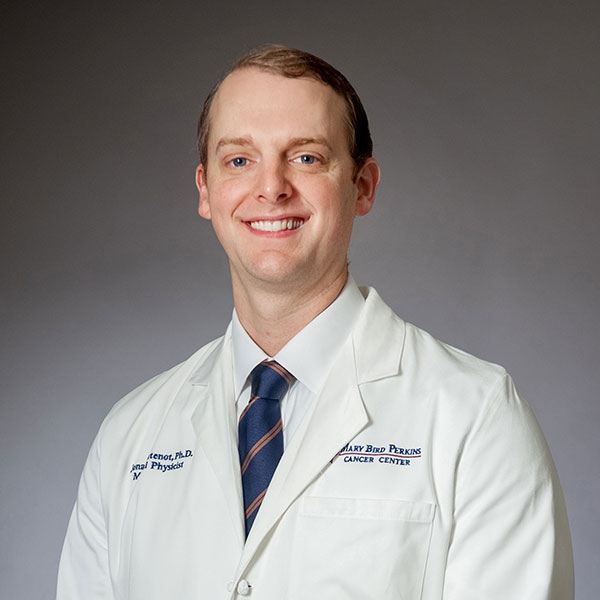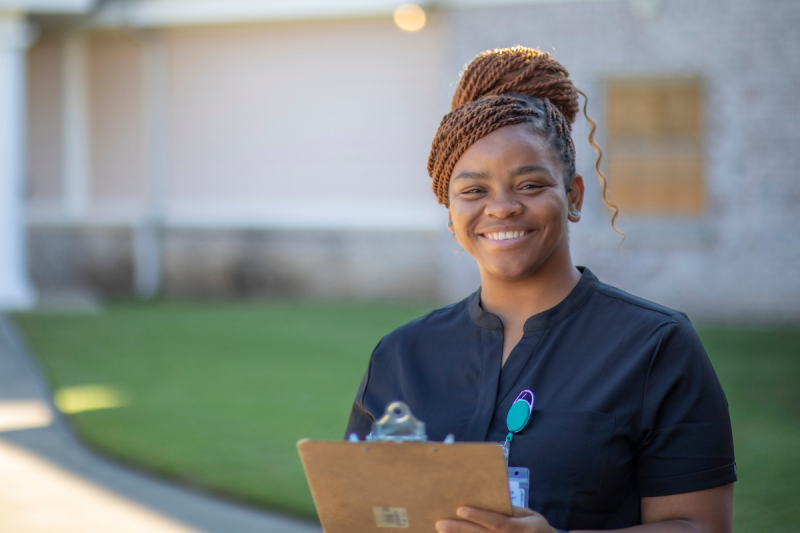Over the last 12 years, Dr. Jonas Fontenot has worked his way from being a staff medical physicist to becoming the chief of physics and chief operating officer at Mary Bird Perkins Cancer Center.
“Medical physicists are interested in using ionizing radiation for the diagnosis and treatment of human disease,” he said. “Within a cancer center, that means that a medical physicist is responsible for serving as an interface between the science of technology and the art of medicine.
“The day-to-day for that particular role involves working with radiation oncologists who see patients who would benefit from radiation therapy and coming up with radiation treatment plans that are customized, unique, and personalized to each patient’s disease and anatomy, and then coming up with strategies to actually deliver those radiation dose plans to patients each and every day,” he said.
“It’s been a wild and fun ride,” he said. “It’s certainly one that I did not anticipate.”
The Road to Medical Physics
The start of his career in medical physics was also unanticipated.
“I knew I was destined for something in science,” Dr. Fontenot said. “I didn’t know exactly what I wanted to do when I got to UL Lafayette, but I had lots of options.
“I started out in engineering but made my way to physics when I realized it was a better match for my interests,” he said.
“What I really enjoyed about physics is that if you know key concepts in a few key areas, you could apply that knowledge and understanding in lots of key areas."
“What drew me to medical physics was accidental,” Dr. Fontenot said. “It was really through a path of discovery that I would attribute to the physics program at UL Lafayette. I think for any physics major at any university, there comes a point in time where you ask, ‘What am I going to do with this physics degree I’m working toward?’”
When the time came for Dr. Fontenot to ask himself that question, the physics faculty were more than happy to help.
“When I first asked myself that question, I had no idea what I might do with a physics degree,” he said. “But the faculty provided a wealth of information about the possibilities that existed for somebody with a physics degree.
“I was made aware of the field of medical physics from Dr. John Meriwether (Professor Emeritus), who was aware of an alumnus of the department who had gone on to a career in medical physics,” Dr. Fontenot said.
“It appealed to me that there was a social component of the career,” he said. “It also appealed to me that it was a field that I could apply physics concepts within applications that would benefit people with a diagnosis of cancer.
“After talking through some of the general concepts of what medical physics was with Dr. Meriwether, he put me in touch with the alumnus that he had mentioned,” he said. “I reached out to him and spent some time with him. I found that time to be productive and interesting to the point that I decided it was something I wanted to pursue.”
Gaining Unanticipated Skills
Once he earned his bachelor’s degree from UL Lafayette, Dr. Fontenot started his graduate training in Houston where he learned more than he was expecting. He earned his Master of Science and his Ph.D. in Medical Physics at M.D. Anderson Cancer Center.
“I think a graduate education and a career in science means you’re often up in front of audiences, talking about research,” he said, “so the first few times I had to get up in front of a national or international crowd and talk about my ideas and things that I was pursuing, I was terrified.
“But with repetition and practice brings confidence and being able to get up in that sort of setting,” he said. “And being able to have a conversation with an audience about the ideas you have. I think that further honed and improved my ability to communicate with others about technically difficult concepts.”
This skill of effective communication has been one that has translated from large-scale audiences to Dr. Fontenot’s patients and staff. It continues to be an asset in his career today.
“The ability and the need to communicate effectively with patients and staff members and physicians in terms they can understand is something I did not expect to spend as much time on,” he said. “But as I gained more experience in the field, I realized that’s really an essential component of this career. That comes with time and experience.
“It’s been what I expected in some ways and not what I expected in other ways,” he said. “It has certainly brought a large degree of satisfaction by being able to apply a skill set that I think not many people have, that benefits cancer patients and has a specific and unique and direct application. That’s been very satisfying.”
Dr. Fontenot's Current Radiation Research
Dr. Fontenot’s research is focused on improving radiation doses to target tumors better. He has numerous publications and received over $1 million in sponsored research funding. He was a key figure in bringing the Gamma Knife Icon to Mary Bird Perkins Cancer Center.
“There is a lot of work that is done before a patient is ever treated with radiation therapy to make sure we get as much dose to the tumor as possible and spare as much normal healthy tissue as we possibly can from being irradiated,” he said. “It’s always a balance – it’s never possible to do all of one and none of another."
“My research is developing new strategies and refining current approaches to improve the balance between treating the tumor and avoiding normal healthy organs,” he said. “I’ve been a part of that avenue of research for a number of years.
“As a group, we’ve been very successful,” he said. “I’ve been part of more than 50 papers that have been published in peer reviewed national and international journals. I’ve been a part of more than $5 million worth of research grants that have helped support that avenue of research.”
The Role of UL Lafayette
Dr. Fontenot already had the ability to grow into someone great. Faculty and classes at UL Lafayette just provided the encouragement to pursue his interests.
“I attribute my experience in the physics program at UL Lafayette to creating the foundation of support upon which my career has ultimately grown,” he said. “I think with the physics knowledge itself, I’ve gotten excellent instruction and training in undergraduate physics concepts.
“I was also afforded the opportunity as an undergrad to take graduate physics courses, which I think strengthened my application to propel me into the No. 1 grad program in medical physics in the country at M.D. Anderson in Houston,” he said.
“The department also provided me with contacts that not only made me aware of the medical physics profession,” he said, “but also connected me with a summer internship in Houston that opened the door for me to get introduced with some of the faculty at M.D. Anderson and ultimately contributed to me getting into that program.
“Ultimately the physics department faculty helped shepherd me into a life and career after college that aligned with my strengths and interests,” said Dr. Fontenot.

